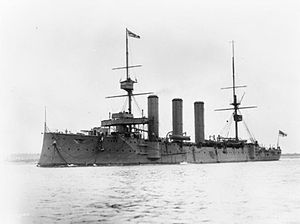HMS Essex (1901)
 Essex at anchor
| |
| History | |
|---|---|
| Name | Essex |
| Namesake | Essex |
| Builder | HM Dockyard, Pembroke, Wales |
| Laid down | 2 January 1900 |
| Launched | 29 August 1901 |
| Completed | 22 March 1904 |
| Fate | Sold for scrap, 8 November 1921 |
| General characteristics | |
| Class and type | armoured cruiser |
| Displacement | 9,800 long tons (10,000 t) (normal) |
| Length | 463 ft 6 in (141.3 m) (o/a) |
| Beam | 66 ft (20.1 m) |
| Draught | 25 ft (7.6 m) |
| Installed power |
|
| Propulsion | 2 × shafts; 2 × triple-expansion steam engines |
| Speed | 23 knots (43 km/h; 26 mph) |
| Complement | 678 |
| Armament |
|
| Armour |
|
HMS Essex was one of 10
After the beginning of
Design and description
The Monmouths were intended to protect British merchant shipping from fast
The Monmouth-class ships' main armament consisted of fourteen
Beginning in 1915, the main deck six-inch guns of the Monmouth-class ships were moved to the upper deck and given
The ship's
Construction and service
Essex, named to commemorate the
After visiting
World War I
When Craddock received the preliminary war warning on 27 July, he ordered Essex to join her sister
Later in the year, she was recommissioned and served as a destroyer depot ship at Devonport.[20] By April 1918, Essex was an accommodation ship there.[21] As of 1 December, she was serving as a training ship,[22] but she reverted to her previous role as an accommodation ship by 1 May 1919.[23] Essex was paid off again by October 1919[24] and was later sold for scrap on 8 November 1921 and broken up in Germany.[7]
Notes
- ^ "Cwt" is the abbreviation for hundredweight, 12 cwt referring to the weight of the gun.
Footnotes
- ^ a b c Roberts, p. 70
- ^ a b Friedman 2012, p. 336
- ^ Friedman 2011, p. 81
- ^ Friedman 2012, pp. 251–252, 260–261
- ^ Friedman 2012, pp. 280, 286
- ^ McBride, p. 21
- ^ a b Silverstone, p. 230
- ^ "Naval & Military Intelligence". The Times. No. 36029. London. 3 January 1900. p. 4.
- ^ "Naval & Military Intelligence". The Times. No. 36547. London. 30 August 1901. p. 8.
- ^ "Naval & Military intelligence". The Times. No. 36878. London. 20 September 1902. p. 9.
- ^ Preston, p. 12
- ^ "The Navy List". National Library of Scotland. London: J. J. Keliher & Co. 18 December 1913. Retrieved 2 April 2016.
- ^ a b c d e f g Transcript
- ^ O'Shaughnessy, pp. 280–285
- ^ O'Shaughnessy, p. 319
- ^ Corbett, I, pp. 45, 47, 136, 263
- ^ Corbett, II, p. 277
- ^ "Supplement to the Monthly Navy List Showing the Organisation of the Fleet, Flag Officer's Commands, &c". National Library of Scotland. Admiralty. June 1915. p. 10. Archived from the original on 31 March 2016. Retrieved 1 April 2016.
- ^ "Supplement to the Monthly Navy List Showing the Organisation of the Fleet, Flag Officer's Commands, &c". National Library of Scotland. Admiralty. July 1915. p. 19. Archived from the original on 1 April 2016. Retrieved 1 April 2016.
- ^ Friedman 2012, p. 343
- ^ "Supplement to the Monthly Navy List Showing the Organisation of the Fleet, Flag Officer's Commands, &c". National Library of Scotland. Admiralty. April 1918. p. 19. Retrieved 1 April 2016.
- ^ "Supplement to the Monthly Navy List Showing the Organisation of the Fleet, Flag Officer's Commands, &c". National Library of Scotland. Admiralty. 1 December 1918. p. 19. Retrieved 1 April 2016.
- ^ "Supplement to the Monthly Navy List Showing the Organisation of the Fleet, Flag Officer's Commands, &c". National Library of Scotland. Admiralty. 1 May 1916. p. 19. Archived from the original on 1 April 2016. Retrieved 1 April 2016.
- ^ "The Navy List". National Library of Scotland. Admiralty. October 1919. p. 711. Archived from the original on 1 April 2016. Retrieved 1 April 2016.
Bibliography
- ISBN 0-89839-256-X.
- Corbett, Julian (1997) [1929]. Naval Operations. History of the Great War: Based on Official Documents. Vol. II (Second ed.). London and Nashville, Tennessee: Imperial War Museum in association with the Battery Press. ISBN 1-870423-74-7.
- Corbett, Julian (1997) [1940]. Naval Operations. History of the Great War: Based on Official Documents. Vol. III (Second ed.). London and Nashville, Tennessee: Imperial War Museum in association with the Battery Press. ISBN 1-870423-50-X.
- ISBN 978-1-59114-068-9.
- Friedman, Norman (2011). Naval Weapons of World War One: Guns, Torpedoes, Mines and ASW Weapons of All Nations; An Illustrated Directory. Barnsley, UK: Seaforth Publishing. ISBN 978-1-84832-100-7.
- ISBN 0-679-45671-6.
- McBride, Keith (1988). "The First County Class Cruisers of the Royal Navy, Part I: The Monmouths". Warship. 46 (April). London: Conway Maritime Press: 19–26. ISSN 0142-6222.
- O'Shaughnessy, Edith (1916). A Diplomat's Wife in Mexico. New York: Harper & Brothers Publishers.
- ISBN 0-85177-245-5.
- Roberts, John (1979). "Great Britain and Empire Forces". In Chesneau, Roger & Kolesnik, Eugene M. (eds.). Conway's All the World's Fighting Ships 1860-1905. Greenwich, UK: Conway Maritime Press. pp. 1–113. ISBN 0-8317-0302-4.
- Silverstone, Paul H. (1984). Directory of the World's Capital Ships. New York: Hippocrene Books. ISBN 0-88254-979-0.
- "Transcript: HMS Essex - January 1914 to August 1916, 4th Cruiser Squadron West Atlantic, North America & West Indies Station, 9th Cruiser Squadron Atlantic (Canary Islands)". Royal Navy Log Books of the World War 1 Era. Naval-History.net. Retrieved 1 March 2014.
